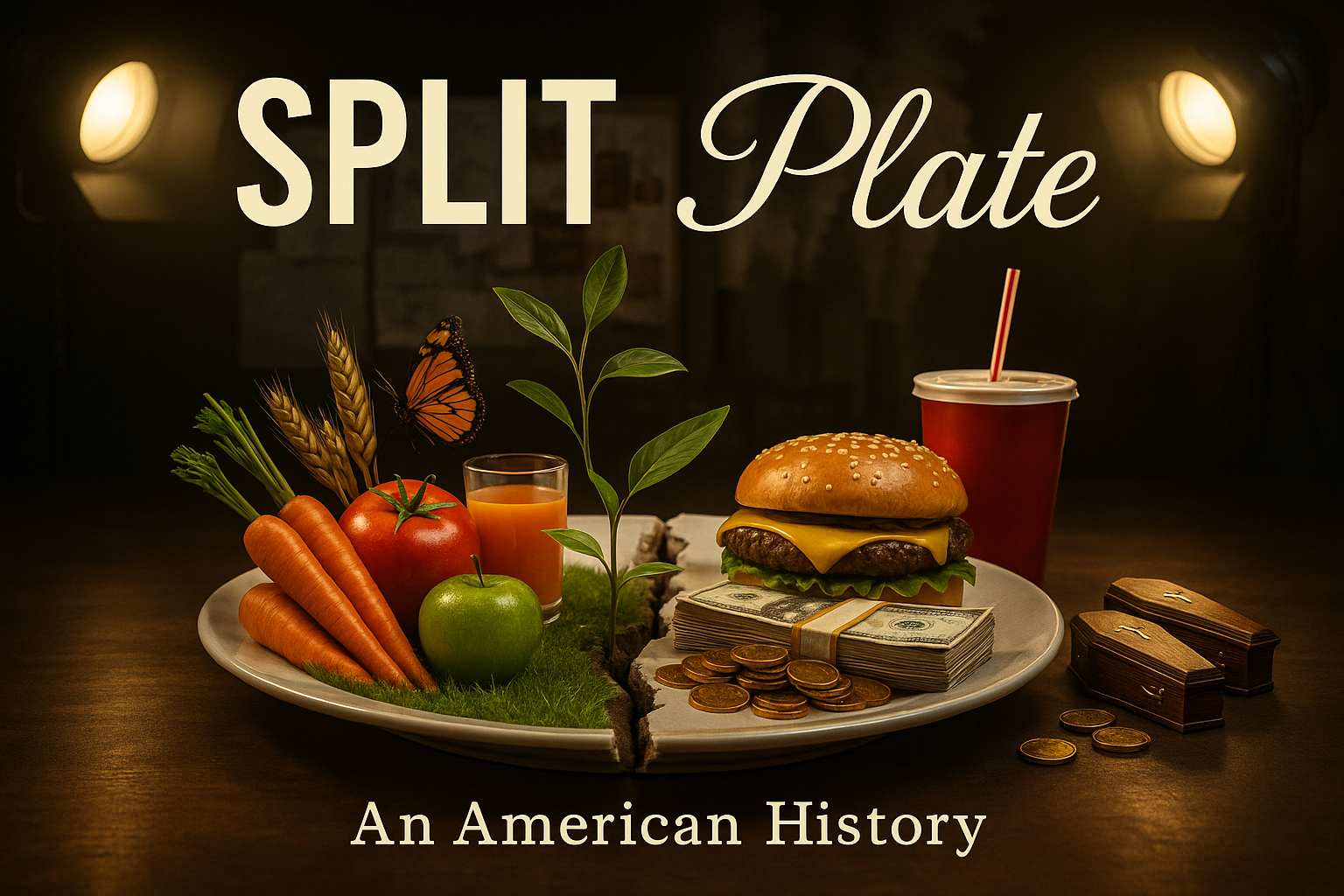
The Documentary Film Project

Split Plate: The Untold History of the Health Food Movement- It's Eccentrics, Fanatics, and Visionaries is a (proposed) 9-part historical documentary series that follows the historical story of what is now known as the “health food” industry- and its broader relationship with the mainstream culinary culture of America. Each episode covers a unique aspect of this history, set against the backdrop of an ever-changing America. Using archival black and white and color footage, as well as contemporary interviews with corporate CEOs, authors, influencers, scientists and others, Split Plate offers a fascinating historical perspective on “how we got here from there” -by standing on the shoulders of the pioneers and bioneers who trail-blazed healthier, and often more compassionate ways of eating, for ourselves, our loved ones, and the planet.
The series culminates with a clear eyed assessment (over two episodes) of the current state of food production- and the choices we all should have access to. Hard questions and issues are talked about including a look at GMOs, food sovereignty, the merging of food and pharma, and more.
The "eccentrics, fanatics, and visionaries" of Split Plate are the real stars of the series, and their colorful personalities, strong beliefs, and courage when facing all sorts of obstacles, ridicule, and societal disapproval make up a large portion of the stories in the series.
Controversies, Conflicts of Interest, Challenges to Change, and Hidden Agendas
• Organic (vs) Chemical agriculture (Rachel Carson vs DDT)
• History of Vitamins -their discovery, adoption, and push back from the medical establishment
• Botanical and Homeopathic medicine vs the AMA medical establishment
• Food safety and consumer protection laws vs agri-business and corporate interests
• Fluoride, margarine, aluminum, teflon, artificial colors, preservatives, MSG, artificial sweeteners and more
• Vegetarianism and veganism- some of the surprising pioneers, authors, and early advocates.
• Natural lifestyle- eccentrics and visionaries, hippies, and the rise of “modern” healthy eating
• The Southern California movement- juicing, muscle beach and the health and beauty icons of Hollywood
• The “anti” movements- anti-dairy, anti-gluten, anti-additives (colors, preservatives, synthetic hormones, etc.)
• The “New-trition” influencers: Raw foodists, and a new generation of conscious eaters
• Cholesterol & Heart Disease: Fact or Fiction?
• Fad diets from oat bran to Atkins
• Natural cures for cancer? Cooperation or competition?
• The Aspartame scandal- deep, dark, and dirty
• The GMOs, turf wars, and "Frankenfoods"
We are currently looking for filmmakers and others who would like to join us in bringing Split Plate: The Untold History of America's Health Food Movement to life. Contact Us Episode Guide
Episode One: The Early Days- An American Cuisine Emerges
Episode Two: You Are What You Eat-Sanitariums and Cereal Barons
Episode Three: Backlash- Eat, Drink, and be Wary
Episode Four: Early Nutrition- A Science Emerges
Episode Five: The Greening of America- Organic Agriculture and Plant-Based Nutrition
Episode Six: A Fast Food Nation Arrives- the Split Widens
Episode Seven: The Beat Goes on: Health Food, Hippies and the 60s.
Episode Eight: The "Newtrition" and The Future of Food
Episode 1
The Early Days:
An American Cuisine Emerges
_________________________________
A new world- the abundance and promise of America; fertility of the land
Native American contributions
European Roots
Manifest Destiny
Thoreau and Walden Pond
The Alcotts
That Old Time Religion (Mary Baker Eddy, The Seventh Day Adventists, and more)
Episode 2
You are what you eat:
Sanitariums and The Cereal Barons
_________________________________
Corn Flake Wars (Kellogg, Post, and Graham- and other flakes)
The Hygiene Movement
Vegetarianism- the early years
Homeopathy- an alternative paradigm, and a threat to the medical monopoly
The Amazing Arnold Ehret
Episode 3
Backlash-
Drink, and be Wary
_________________________________
The crusade of Harvey Wiley
100 Million Guinea Pigs
The FDA and Delaney
The Medical Mussolini
Upton Sinclair
Arsenic Apples and Lead Fruit- the first pesticides
Flexner report
Episode 4
Early Nutrition:
A Science Emerges
_________________________________
Show us your teeth: The world travels of Weston Price, DDS
Vitamania: Hope, hype, and the nutrition revolution
The Naysayers: Frederick Stare, Victor Herbert, and sugar coated science
Cyclamates and Saccharin- sweet and dangerous
Linus Pauling PhD and Roger Williams, PhD- scientific nutritional heavy weights
Edgar Cayce- The Sleeping Prophet's Nutrition
Episode 5
The Greening of America:
Herbalism and Plant Medicine
_________________________________
Andrew Weil, M.D. Christopher Hobbs
Rosemary Gladstar -Plantsavers
Ryan Drum- the seaweed revolution
Brigitte Mars interview
Anne Wigmore -wheatgrass juice and the cure for everything
Michael Blumenthal (ABC) Botanical science
Michael and Martha Volchok (entrepreneurs)
Paul Stamets’ mushroom revolution
Cannanaboids and psychedelics
Episode 6
In the Shadow of the Giants:
A Fast Food Nation Arrives- The Split Widens
_________________________________
Golden Arches and Drive-Ins
California Dreaming: Muscle Beach and Hollywood (Jack LaLanne, Paul Bragg, Gypsy Boots, Gloria Swanson)
Garbo’s Guru
Adelle Davis, Superstar
The Organic Movement Finds its Voice: J.I. Rodale Inspires Everyday Gardeners
Rachel Carson’s Silent Spring
The first “super” foods- bee pollen, wheat germ, carrot juice, nutritional yeast, more.
Episode 7
The ‘60s- Back to Eden:
Hippies, Health Food and Revolution
_________________________________
The Beat goes on: Hippies and the ‘back to the land’ movement
Living the Good Life: the story of Helen and Scott Nearing
Mother Earth News
Diet for a Small Planet- Frances Moore Lappe
John Robbins- Diet for a New America
Sugar Blues – William Dufty
Kushi and the Macrobiotic Revolution: brown rice, seaweed, and tofu, oh my!
The Celestial Seasonings story and the fresh new health food entrepreneurs
Episode 8
Cracks in the Wall
The Great Poisoning Arrives
___________________________________
Silent Spring- Rachel Carson touches off a firestorm. A new divide hardens. And the relationships between health, food, and environmentalism crystallizes.
The great Cranberry scare of 1959
Poisoned (Alar) apples anyone? (1989)
Love Canal (1978)
Dupont, Teflon, and “forever chemicals” (Hoosick Falls, NY, 2014-2016)
A slew of warnings forebodings, and tragedies: Bhopal (1984), Three-Mile Island (1979)
Mad Cow Disease (1996)
Tryptophan/EMS (eosinophilia myalgia syndrome), 1989
Glyphosate, GMOs, and Frankenfoods
Catherine Austin Fitts and “The Great Poisoning”
Episode 9
The Frontier of Food
Challenges and Opportunities
__________________________________
Jeffrey Bland, Ph.D. on the human genome,and food- the frontier of nutrition
Vandana Shiva- saving farmers- worldwide
Catherine Austin Fitts and “The Great Poisoning”
Food Sovereignty vs Control Grids, Consumer choices, Food
Food Pharma
Transparency and scale
John Mackey brings organic and natural to the whole country
John Robbins (Diet for a New America)
Charles Eisentein (The More Beautiful World Our Hearts Know is Possible)
William Tuttle and the World Peace Diet
Browse episode topics and short summaries.




